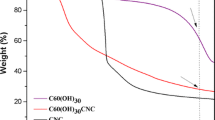Oxidized cotton cellulose with COOH contents of 16.0–24.0%, meeting USP requirements, was produced in the HNO3–H3PO4–NaNO2 system. This allowed it to be used as a biodegradable hemostatic agent. The structures of oxidized cotton celluloses were confirmed using IR spectroscopy and elemental analysis and were studied using X-ray diffraction structure analysis. Diffraction patterns of celluloses oxidized for 4–24 h had reflections characteristic of two polymorphic modifications, i.e., cellulose I (characteristic of starting cotton cellulose) and cellulose II.


Similar content being viewed by others
References
K. M. Lewis, D. Spazierer, M. D. Urban, L. Lin, H. Redl, and A. Goppelt, Eur. Surg.-Acta Chir. Austriaca, 45, 213 (2013).
S. Keshavarzi, M. MacDougall, D. Lulic, A. Kasasbeh, and M. Levy, Wounds Compend. Clin. Res. Pract., 25, 160 (2013).
S. Dan Dimitrijevich, M. Tatarko, R. W. Gracy, G. E. Wise, L. X. Oakford, C. B. Linsky, and L. Kamp, Carbohydr. Res., 198, 331 (1990).
F. Xie, P. De Wever, P. Fardim, and G. Van den Mooter, Molecules, 26, 1030 (2021).
A. M. Pierce, D. Wilson, and O. Wiebkin, Int. J. Oral Maxillofac. Surg., 16, 33 8 (1987).
A. Pierce, O. Wiebkin, and D. Wilson, J. Oral Pathol. Med., 13, 661 (1984).
W. D. Spotnitz and S. Burks, Transfusion, 52, 2243 (2012).
Y. D. Wu, J. M. He, Y. D. Huang, F. W. Wang, and F. Tang, Fibers Polym., 13, 576 (2012).
V. E. Kaputskii, T. L. Yurkshtovich, M. D. Balabaeva, and F. N. Kaputskii, Vestn. Beloruss. Univ., Ser. 2, No. 1, 15 (1978).
R. I. Sarybeava and L. S. Shchelokhova, Chemistry of Cellulose Nitrate Esters [in Russian], Ilim, Frunze, 1985, 164 pp.
E. D. Kaverzneva and A. S. Salova, Zh. Anal. Khim., 8, 365 (1953).
V. I. Azarov, A. V. Burov, and A. V. Obolenskaya, Chemistry of Wood and Synthetic Polymers: Textbook for Students of Higher Education Institutions Training in the Specialty “Technology of Chemical Wood Processing” [in Russian], St. Petersburg State Forestry Technical Academy, St. Petersburg, 1999, 628 pp.
Acknowledgment
The work was financially supported by State Research Program “Chemical Processes, Reagents and Technology, Bioregulators and Bioorganic Chemistry,” NIR 2.2.02.06.
Author information
Authors and Affiliations
Corresponding author
Additional information
Translated from Khimiya Prirodnykh Soedinenii, No. 1, January–February, 2023, pp. 9–12.
Rights and permissions
Springer Nature or its licensor (e.g. a society or other partner) holds exclusive rights to this article under a publishing agreement with the author(s) or other rightsholder(s); author self-archiving of the accepted manuscript version of this article is solely governed by the terms of such publishing agreement and applicable law.
About this article
Cite this article
Butrim, S.M., Bil’dyukevich, T.D., Butrim, N.S. et al. Effect of Oxidation in the HNO3–H3PO4–NaNO2 System on the Structure and Properties of Cotton Cellulose. Chem Nat Compd 59, 6–10 (2023). https://doi.org/10.1007/s10600-023-03906-y
Received:
Published:
Issue Date:
DOI: https://doi.org/10.1007/s10600-023-03906-y




